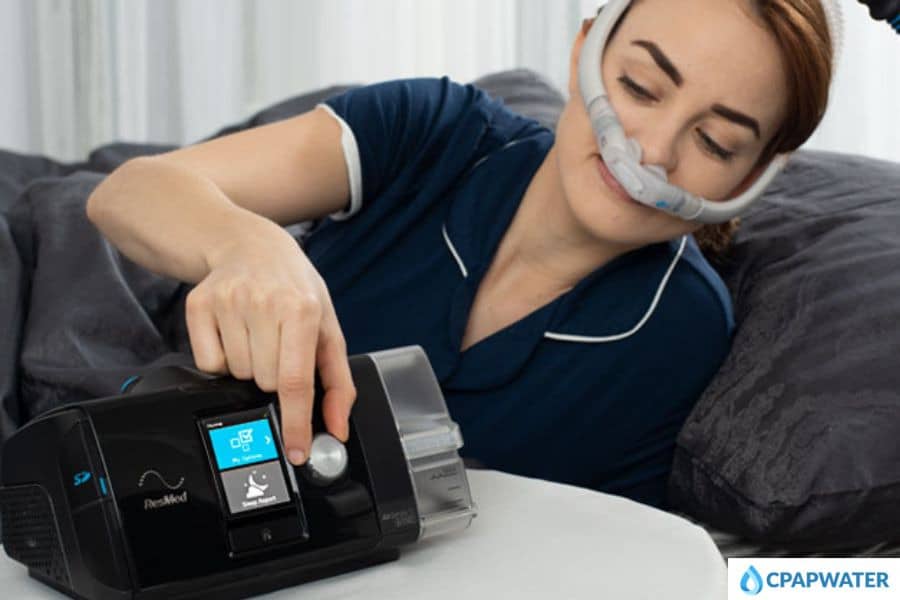What is EPR on CPAP?
If you’re undergoing CPAP therapy for sleep apnea, understanding the role of EPR (Expiratory Pressure Relief) is crucial. EPR is a valuable feature in specific CPAP machines that aims to enhance user comfort and the effectiveness of therapy.
In this article, we at CPAPwater will delve into the functionality and benefits of EPR on CPAP, exploring how it works and its advantages.
Decoding EPR (Expiratory Pressure Relief)

When it comes to CPAP therapy, understanding the role of (EPR) or Expiratory Pressure Relief is essential. EPR is a feature in specific CPAP machines that aims to improve the therapy experience. It reduces the air pressure during exhalation, providing users a more natural and comfortable breathing pattern.
EPR is designed to work hand in hand with the primary function of CPAP machines, which is to keep the airways open and maintain consistent positive airway pressure (PAP) during sleep. By reducing air pressure during exhalation, EPR helps alleviate any resistance or discomfort some users may experience, making the therapy more tolerable and effective.
The primary purpose of EPR is to enhance user comfort and improve therapy effectiveness. Reducing the pressure during exhalation mimics a more natural breathing pattern and reduces the feeling of air trapping. This can lead to improved compliance and increased therapy adherence, as users are more likely to continue their treatment when they feel comfortable throughout the night.
How EPR Works
EPR operates based on a simple yet ingenious principle. When enabled, the CPAP machine detects the onset of exhalation and automatically adjusts the pressure to provide relief. This adjustment is achieved through a valve mechanism within the device, which allows the pressure to decrease during exhalation while maintaining the prescribed therapeutic pressure during inhalation.
One of the critical advantages of EPR is its adjustability, offering users the ability to customize the degree of pressure relief during exhalation at three pressure points according to their comfort and needs.
CPAP machines equipped with EPR typically offer multiple levels or pressure settings, including the ability to adjust the normal pressure setting, through the machine’s menu or settings interface. This feature provides users with flexibility and customization options to suit their individual preferences and ensure optimal comfort during therapy.
During the exhalation phase, the EPR feature dynamically adjusts the pressure to provide a more comfortable breathing experience. As the user begins to exhale, the CPAP machine senses the change in airflow and promptly reduces the pressure. This reduction helps alleviate any sensation of resistance or difficulty in exhaling, allowing for a more natural and relaxed breathing pattern throughout the night.
Benefits of EPR On CPAP
One of the primary benefits of EPR on CPAP is its ability to enhance the overall therapy experience. By reducing the pressure during exhalation, EPR helps users feel less restricted, allowing for a smoother and more comfortable breathing cycle. This can lead to improved sleep quality, reduced interruptions during the night, and a better experience with CPAP therapy.
EPR can significantly reduce airway resistance and alleviate the effort required during exhalation. This reduction in resistance makes it easier for users to breathe out against the air pressure delivered by the CPAP machine.
Comfort is crucial in promoting therapy compliance, and EPR helps. When users find the therapy more comfortable and less burdensome, they are more likely to adhere to their prescribed treatment consistently. By improving compliance, EPR contributes to better treatment outcomes, as consistent and effective CPAP therapy is vital in managing sleep apnea and its associated symptoms.
Optimizing EPR Settings
When optimizing EPR settings, finding the right balance for your specific needs is essential. The optimal EPR level may vary from person to person, depending on individual comfort, breathing patterns, and the severity of obstructive sleep apnea.
Generally, starting with lower EPR levels and gradually increasing as needed is recommended, finding the setting that provides the best balance of comfort and therapy effectiveness.
To ensure the most suitable EPR settings for your unique circumstances, it’s crucial to consult with a healthcare professional or your prescribing physician. They have the expertise and understanding of your specific sleep apnea condition and can provide personalized guidance on adjusting EPR levels. Their professional insight can help you navigate potential considerations and optimize your therapy experience.
When adjusting EPR settings, it’s essential to be mindful of certain factors. One consideration is finding the right balance between pressure relief and maintaining effective therapy. While higher EPR levels may provide more significant relief, they should not compromise the therapeutic pressure necessary for effective treatment.
Additionally, some CPAP users may require more time to adapt to changes in EPR settings, so monitoring any changes in sleep quality or comfort during the adjustment period is essential.
When To Consider EPR For Your Sleep Apnea Therapy

If you’ve been grappling with specific symptoms during your sleep apnea therapy, it might be a sign that EPR could benefit you. Pay attention if you experience feelings of suffocation, persistent dryness in your mouth either overnight or upon waking, or frequently face issues with your mask losing its seal.
These symptoms can be addressed by adjusting your CPAP settings, and including EPR makes personalization more accessible than ever before.
For those considering EPR, the ResMed AirSense 10 offers this feature. With four adjustable settings available (ranging from 0 to 3), users can experiment to find the most appropriate level of pressure relief.
This customization empowers individuals to fine-tune their therapy experience according to their unique comfort requirements, helping to optimize the effectiveness of their sleep apnea treatment.
Harnessing Advanced CPAP Technology For Restful Sleep
With the advancements in sleep therapy devices, including the innovative EPR technology found in Respironics CPAP machines, achieving restful sleep has become more attainable. The evolution of CPAP technology, particularly Respironics CPAP machines, has significantly improved comfort and therapy effectiveness.
These advancements have revolutionized the sleep therapy landscape, offering individuals a better chance to experience quality sleep and manage their sleep apnea effectively.
If you have further inquiries or seek additional information about this cutting-edge system, it is highly recommended to consult with your physician. Embrace the power of modern CPAP technology and experience the rejuvenating sleep you deserve.
Enhance your CPAP experience with our premium CPAP accessories, tailored to improve comfort and therapy effectiveness. Click now and take the first step towards better sleep quality.
Have thoughts on this article? Share it and let’s discuss!



